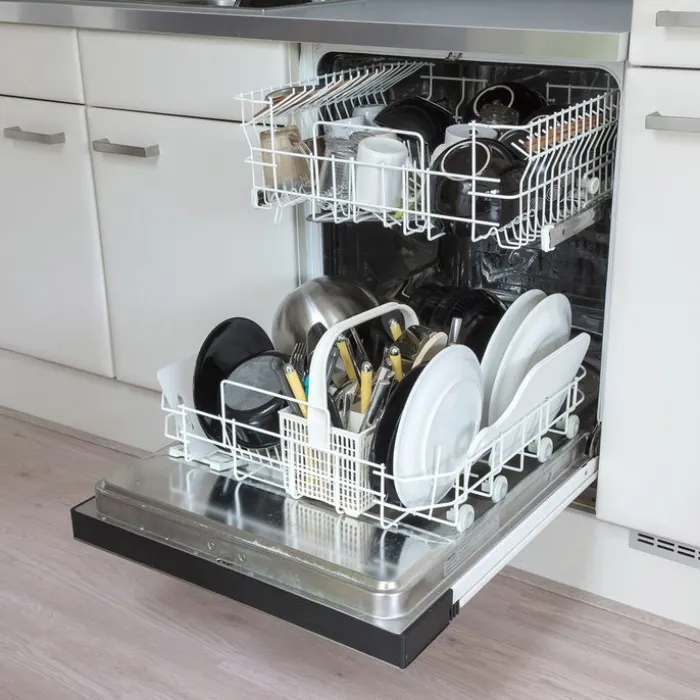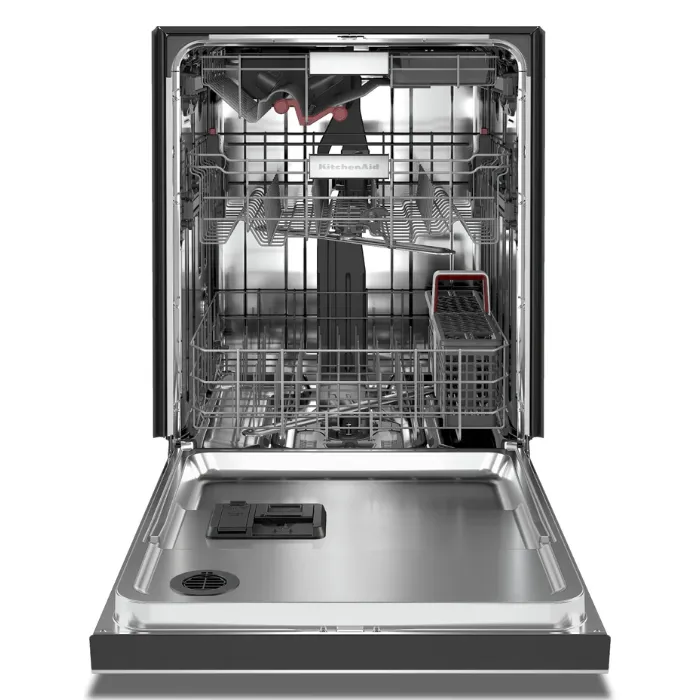A dishwasher installation kit with a 90-degree fitting and water supply line is necessary as well as the right knowledge and tools to complete the job successfully. This guide outlines how to install a dishwasher.
- Pick the Right Dishwasher
- Remove the Old Dishwasher
- Connect to the Water Supply and Adjust Height
- Get the Dishwasher in Place
- Secure Your Dishwasher to the Countertop and Cabinets
- Connect Hoses and Power and Test the Dishwasher
- Test It Out
- Level and Anchor It
Please read on.
What You Need to Replace a Dishwasher
If you have taken accurate measurements and your new dishwasher will fit in the space under your bench, replacing an existing dishwasher is a fairly simple task. There is already all the necessary infrastructure in place, including power, water, drainage, and space. The majority of the time, replacing an appliance just requires removing the old one, attaching the new one to the drain and inlet tap, and plugging it in.
How to Install a Dishwasher?
Below are the specific details:
Pick the Right Dishwasher
Since purchasing a dishwasher is an investment, you should make sure it will continue to give you spotlessly clean dishes for many years.
Consider the features you might want while shopping, such as a designated spot for your wine glasses or a third rack for your flatware.
Then, think through other key buying factors, like:
- Noise level
- Cycle options, like express cleaning or rinse-only
- Efficiency (fortunately, virtually any dishwasher will save waterover hand washing)
- Finish
Don’t make this choice hastily. Make an informed decision and choose the dishwasher that is best for you.
Nobody would be critical of you if you assumed that a dishwasher uses a sizable amount of water for each load. After all, one of the largest appliances in your home is usually this one. You may have wondered how much water does a dishwasher use.

Remove the Old Dishwasher
Read the manufacturer’s installation instructions for a dishwasher before you start dismantling the old unit. It might include details specific to your new appliance, like any additional parts that might be required for that model.
- At the circuit breaker, turn off the electricity to the dishwasher.
- At the shut-off valve under the sink, stop the water flow.
- The front access panel near the floor should be removed with a screwdriver.
- Remove the old wiring connections from the terminal box.
- Using an adjustable wrench, disconnect the dishwasher’s old water supply line.
- If any water leaks after you remove the nut, place a small bowl underneath the connection to catch it.
- The dishwasher’s drain hose must be disconnected.
- Remove the screws from the brackets holding the dishwasher to the base of the countertop and the surrounding cabinets.
- To prevent damaging the floor, spread a drop cloth or piece of cardboard on the area in front of the appliance.
- Remove and relocate the outdated dishwasher.
- To prevent it from being damaged when the new dishwasher is installed, tape the existing electrical cable to the floor.
Connect to the Water Supply and Adjust Height
Connect the fill hose to the valve on the dishwasher’s bottom, then connect the elbow hose fitting to the water supply line and direct it toward the back of the dishwasher. Tighten manually, then use pliers to turn the screw a further 1/4 to 1/2 turn.
Rear leveling legs should be adjusted to match cabinet opening height by measuring the distance from the floor to the underside of the countertop.
Get the Dishwasher in Place
The dishwasher should now be carefully tipped over to be upright if it was previously on its back. Push it into the area beneath your counter with caution and slowly.
To make sure that any slack doesn’t get caught under the dishwasher, you might want to have a second person pull the power cord, water supply hose, and drain hose through the hole in your cabinet as you do this. Any extra can be redirected behind the dishwasher once it is in position.
Secure Your Dishwasher to the Countertop and Cabinets
When the dishwasher door is flush with the front of the adjacent cabinet doors, slide the dishwasher back into place by inserting anchor brackets into the open slots on the left- and right-hand tops of the dishwasher collar or into slots on each side of the dishwasher. Adjust the front leveling legs until the dishwasher is level, checking for levelness up and down the door and along the top edge. Anchor brackets should then be screwed in.
Suggested reading: How long do dishwashers last? This guide will tell you how to prolong the life of your dishwasher and keep it in good working condition.
Connect Hoses and Power and Test the Dishwasher
Connect Hoses
Turn on the manual shut-off valve after connecting the hot water line to the water supply line. To the drain port, attach the drain hose. Make sure to remove the disposal drain plug and knock it out of the way before connecting the dishwasher drain if you’re connecting to a new drain disposal. Connect the drip tray to the dishwasher if it is a Maytag brand dishwasher, and then push it down toward the bottom. Connect the electrical cord.
Run a Test Cycle and Attach Toe Panel
For information on how to run a test cycle to look for leaks, refer to the dishwasher installation instructions. Replace the access panel and toe panel after adding insulation to the door’s subframe. In order to showcase your brand-new, dependable dishwasher properly, don’t forget to remove the protective film from the door and the interior racks.
Test It Out
Run a complete cycle before you spend the time positioning and securing your dishwasher. Don’t forget to restart the power and water first.
At least you made the electrical connections correctly if the dishwasher turns on. If it doesn’t, you might want to get assistance from a nearby electrician.
Look for leaks both during and after the operation. As necessary, tighten any connections, taking care to do so gradually to prevent overtightening.

Level and Anchor It
Grab some pliers after making sure the dishwasher is operating as it should. Utilize them to move the dishwasher’s legs so that they are flush with your countertop. To make sure it’s level, grab your level; otherwise, drainage issues may arise.
The dishwasher can now be secured to the underside of your cabinet and the adjacent cabinets using the brackets that came with it.
The front access panel should then be reattached.
Other Important Things to Think About When Installing a Dishwasher
You must remove the cabinet unit where your dishwasher will be located if you’re retrofitting a dishwasher into an existing kitchen. Although you might be able to do this yourself, it would probably be wise to hire a pro in case you end up damaging other components of your kitchen.
Next, you should think about your counters. Laminated benchtops can be damaged by steam and water spills from your dishwasher, so it’s critical to make sure the undersides of benches are sealed to reduce the risk of water damage.
Last but not least, the majority of dishwashers—especially built-under models—are large, cumbersome appliances with numerous sharp edges. Use caution when handling them. To make moving it into the kitchen easier, enlist the aid of a friend or family member.
FAQs
Do You Need a Plumber to Install a Dishwasher?
Yes, plumbers do install dishwashers! You should also hire a plumber to install your new dishwasher. Many home improvement tasks can be completed on your own, but it’s best to hire a licensed professional to install appliances that need plumbing expertise.
Does a Dishwasher Hook Up to Cold Or Hot Water?
Dishwashers are connected to your home’s hot water connection. There’s a good chance your dishwasher also has a heating element, which is typically found at the tub’s base. Even hotter than the water coming from your faucet, the heating element can heat the water. Find out what to do if the water in your dishwasher is not working.
Read about How to Load a Dishwasher?
Summary: How to Install a Dishwasher
The underside of your kitchen countertop and the spaces between your lower cabinets are designed to accommodate a built-in dishwasher. Installing one is a do-it-yourself project you can handle, but you’ll need to carefully connect the necessary electrical, water supply, and drain lines. In case your new dishwasher has front hookups, position it first before making the last connections. Make the last connections before pushing it into position if it has rear hookups. In any case, be sure to carefully follow the appliance’s installation instructions so you can get those dishes done!



